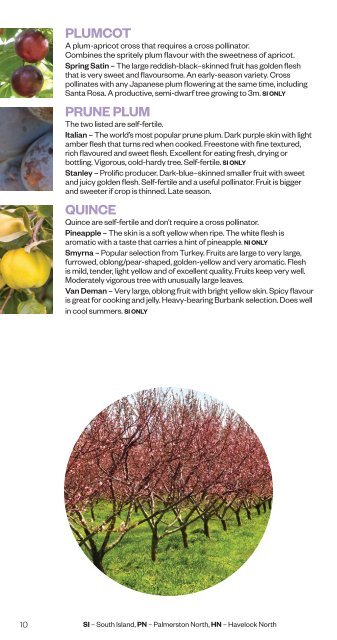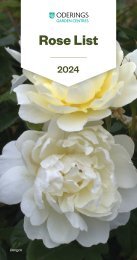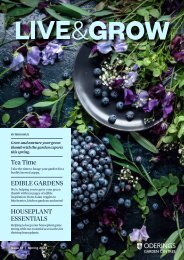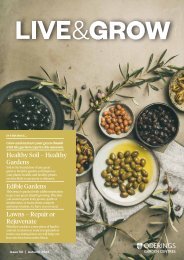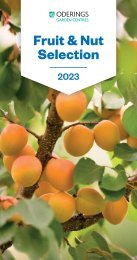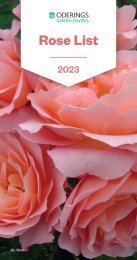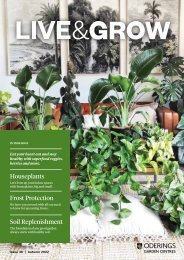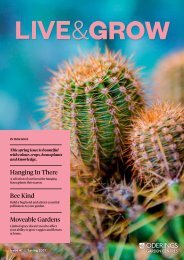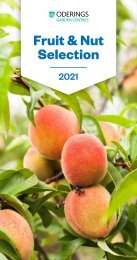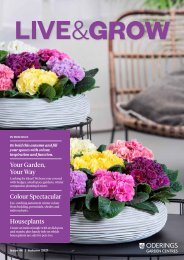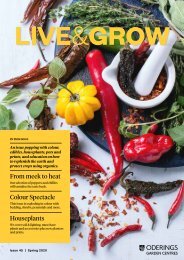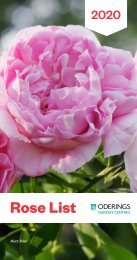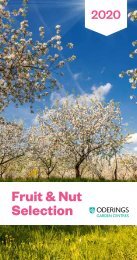Fruit & Nut Selection 2024
Discover our wide array of fruit and nut trees available, including apples, pears, plum trees, and many more options.
Discover our wide array of fruit and nut trees available, including apples, pears, plum trees, and many more options.
You also want an ePaper? Increase the reach of your titles
YUMPU automatically turns print PDFs into web optimized ePapers that Google loves.
PLUMCOT<br />
A plum-apricot cross that requires a cross pollinator.<br />
Combines the spritely plum flavour with the sweetness of apricot.<br />
Spring Satin – The large reddish-black–skinned fruit has golden flesh<br />
that is very sweet and flavoursome. An early-season variety. Cross<br />
pollinates with any Japanese plum flowering at the same time, including<br />
Santa Rosa. A productive, semi-dwarf tree growing to 3m. SI ONLY<br />
PRUNE PLUM<br />
The two listed are self-fertile.<br />
Italian – The world’s most popular prune plum. Dark purple skin with light<br />
amber flesh that turns red when cooked. Freestone with fine textured,<br />
rich flavoured and sweet flesh. Excellent for eating fresh, drying or<br />
bottling. Vigorous, cold-hardy tree. Self-fertile. SI ONLY<br />
Stanley – Prolific producer. Dark-blue–skinned smaller fruit with sweet<br />
and juicy golden flesh. Self-fertile and a useful pollinator. <strong>Fruit</strong> is bigger<br />
and sweeter if crop is thinned. Late season.<br />
QUINCE<br />
Quince are self-fertile and don’t require a cross pollinator.<br />
Pineapple – The skin is a soft yellow when ripe. The white flesh is<br />
aromatic with a taste that carries a hint of pineapple. NI ONLY<br />
Smyrna – Popular selection from Turkey. <strong>Fruit</strong>s are large to very large,<br />
furrowed, oblong/pear-shaped, golden-yellow and very aromatic. Flesh<br />
is mild, tender, light yellow and of excellent quality. <strong>Fruit</strong>s keep very well.<br />
Moderately vigorous tree with unusually large leaves.<br />
Van Deman – Very large, oblong fruit with bright yellow skin. Spicy flavour<br />
is great for cooking and jelly. Heavy-bearing Burbank selection. Does well<br />
in cool summers. SI ONLY<br />
FRUIT TREE CARE<br />
Planting: Although Planting: Although fruit trees should be planted in late winter<br />
or early spring, they can be planted at any time of year provided ample water is<br />
provided while they establish themselves. The root system of a dwarf fruit tree is<br />
not as vigorous as standard fruit trees and will soon die if in poorly drained soil.<br />
At the time of planting, place a stake in the ground 15cm (6 inches) from the stem<br />
of your tree. Pack top soil around the roots and water well. When planting into a<br />
pot, plant in Oderings <strong>Fruit</strong> & Veggie Mix.<br />
Fertilising in the garden: At the time of planting add lime (no more fertiliser is<br />
required in the first year). In future years to achieve a good canopy with a dark<br />
green appearance, use plenty of well-rotted animal manure; we recommend<br />
sheep pellets. Apply Citrus & <strong>Fruit</strong> Tree Fertiliser at 3–4 month intervals once<br />
new growth appears. It is a good idea to mulch your trees; this provides a better<br />
uptake of nutrients and ensures an even supply of moisture, as well as keeping the<br />
roots cooler. Promote the growth of flowering buds with an autumn application of<br />
potassium in the form of Sulphate of Potash.<br />
Fertilising in pots: Use Sulphate of Potash or ‘Yates <strong>Fruit</strong> & Flower Booster Liquid<br />
Potash’, both which can be diluted and then applied with a watering can over soil<br />
at 2–3 week intervals over the growing season. Alternatively use Oderings Total<br />
Replenish in spring; this is a slow-release fertiliser that will feed the plant for six<br />
months. Then during flowering and fruiting, incorporate the Yates <strong>Fruit</strong> & Flower<br />
Booster Liquid Potash every three weeks until harvest. This is also suitable for use<br />
for fruit trees grown in the ground.<br />
Pruning/thinning: If your tree produces fruit in their first year, this fruit should be<br />
removed in the interest of succeeding crops. If you intend to train a tree on a wall<br />
or trellis, fasten the branches to wires on the wall during their first year and remove<br />
new branches that form and grow upright; this will encourage open growth. Plant<br />
your fruit trees 2.5–5m apart depending on varieties. For more info on pruning,<br />
please see our Deciduous <strong>Fruit</strong> Tree Pruning brochure in store or online.<br />
Dwarf fruit trees will set more fruit than they can carry and if not thinned may not<br />
bloom the following year. 20 days after blooming thin out the extra little fruits; try to<br />
have one fruit for each 15–20cm (6–8 inches) along a branch.<br />
Watering: The most common reason some plants do not thrive is either<br />
overwatering or under watering. Plants should be watered only as needed. For<br />
most plants, the upper surface of the soil should be allowed to become dry to<br />
touch before watering. Water thoroughly by slowly filling the container or leaving<br />
water running over the soil around the plant in the garden for a good 30 seconds.<br />
Good drainage is essential. Generally watering will need to be done 2–3 times<br />
a week during early to mid-spring, while almost daily watering may be required<br />
during the hot summer months. If incorporating mulch each season this will help<br />
to reduce your watering and help to maintain a constant soil temperature for the<br />
plants, giving consistent growth and fruit. During autumn and winter, watering<br />
should only be done when the plants are dry – probably every 2–3 weeks in<br />
containers and every month or so in the garden.<br />
Spraying: Like all plants the key to low maintenance is having very healthy plants.<br />
Personally, I incorporate Ocean Solids or a seaweed-based fertiliser for all my<br />
edible plants. This will also ensure that plants are less susceptible to diseases or<br />
insect infestations.<br />
For more details on winter spraying of your fruit trees, please see our Winter<br />
Spraying brochure in store or online, and for a spring/summer spraying regime,<br />
use any of the following. (Please remember, if you want to use the correct<br />
spray, bring in a few leaves for diagnosis as this is just a general guide only.) Our<br />
recommendations are Nature’s Way <strong>Fruit</strong> & Veggie Gun or Yates Success Ultra<br />
for insect issues and Yates Fungus Gun for funguses.<br />
For more information, please visit us in store or online at www.oderings.co.nz for a<br />
free gardening guide brochure.<br />
10 SI – South Island, PN – Palmerston North, HN – Havelock North<br />
www.oderings.co.nz<br />
11


